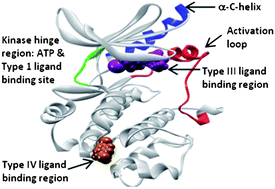Major challenges currently exist in kinase research, such as being able to achieve selectivity between the large numbers of similarly structured family members all processing the same substrate. In addition to requiring this selectivity, ATP site inhibitors must also bind tightly to the kinase catalytic centre to overcome the high physiological concentration of ATP in the cell. And, as many ATP competitive scaffolds have already been discovered, the development of novel ATP site inhibitors is becoming increasingly more difficult.

–Screens to identify non-ATP site kinase binders
-Computational methods to identify non-ATP site kinase binders
-Small molecule spin-labeled probes to identify non-ATP site kinase binders
This review is part of MedChemComm’s New Talent themed issue; read the full article and visit the MedChemComm webpage to see other articles from this collection.
Approaches to discover non-ATP site kinase inhibitors
Lori Krim Gavrin and Eddine Saiah
DOI: 10.1039/C2MD20180A










